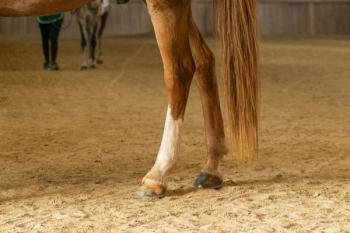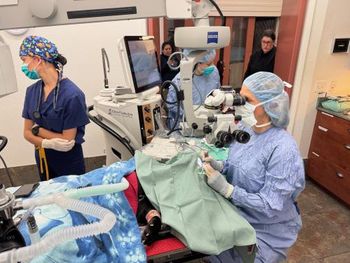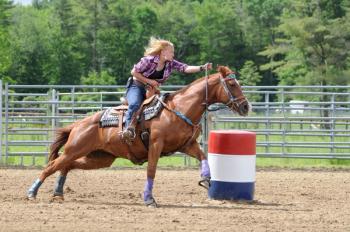
Diagnosis and treatment of secondary ocular diseases in horses (Proceedings)
Equine recurrent uveitis is an immune-mediated disease characterized by delayed hypersensitivity reactions.
Equine recurrent uveitis
Etiology of ERU
- No Single Cause Identified
- Infectious Agent Association
o Trigger or Initiating factor
o Disruption of blood ocular barrier
o Activation of immune response in the eye
- Antibodies to foreign antigens
- Antibodies to self antigens
- Ultimately an immune-mediated disease
Equine recurrent uveitis
Any disease capable of producing a chronic or recurrent sensitization of the vascular tunic of the eye. ERU is an immune-mediated disease characterized by delayed hypersensitivity reactions. Potential etiologies include keratouveitis; microbial infections - Leptospira spp. (L. pomona most commonly implicated), Brucella abortus, Streptococcus spp. (Streptococcus equi); Toxoplasma gondii; parainfluenza-3 virus (PI-3); equine viral arteritis virus (EVA); equine influenza virus (EIV); and parasitic infections - Onchocerca cervicalis microfilaria, Strongylus vulgaris. Other suggested inciting conditions include fungi, Chlamydia, mycoplasma, dental abscesses, endotoxemias (pyelonephritis, endometritis), lymphatic neoplasia, blood dyscrasias, and uveal tract trauma with secondary immune reaction.
Leptospirosis and uveitis
- Strong relationship shown
o Horses w/serum titers >100
- 13.2 x more likely to show signs of uveitits
- 4.4 x more likely to lose vision
o Appaloosas w/ serum titers >100
- 8.3 x more likely to develop uveitis than other breeds
- 3.8 x more likely to lose vision after developing dz
o Ocular signs come late
- 12-15 months after inoculation
Clinical signs
Acute Stage ........ Quiescent Stage
Blepharospasm ...... Posterior synechia
Photophobia ...... Pigmt on ant. Lens capsule
Lacrimation ...... Corneal edema
Miosis ...... Hypopyon
Aqueous flare ...... Secondary cataract
Impaired vision ...... Lens luxation
+ Hyphema ...... Yellow vitreous
+ Blepharitis ...... Vitreous floaters
Retinal traction bands
Retinal dtachment
Fundic lesions
Phthisis bulbi
Conjunctiva and cornea
- Serous to mucopurulent discharge
- Conjunctival chemosis & hyperemia
- Corneal edema
o Inflammatory damage to endothelium
- 360° vascularization of the cornea
Anterior chamber
- Aqueous Flare
o Non-cellular exudate accumulation
- Causes ciliary body dysfunction
- Decrease aqueous production ? hypotonia
Iris and ciliary body
- Ciliary & Iris muscle
o Spasm = Miosis
- Dull iris
- Mottled pigmentation
- Hyperpigmentation
- Hyperemia
- Atrophy of Granular iridica
Lens
- Acute
o Exudate/fibrin
- Chronic
o Pigment
o Posterior Synechia
- Cataract
- Lens Luxation
Posterior uvea
- Inflammatory cells
o Accumulate in vitreous
o Yellow discoloration
- Traction bands
- Vitreal liquefaction
- Retinal Detachment
Retinal changes
- Peripapillary scars
o Butterfly lesions
- Multiple circular
o Target lesions
- Changes in reflectivity
- Detachment
- Optic Nerve Damage
Glaucoma
- Inflammatory cell accumulation in aqueous outflow channels
- Edema/striae/vascularization
Diagnostics and ERU
- Physical
o is there a site of infection/inflammation?
- Complete blood count & biochemistry
- Leptospira (microagglutination test)
o Leptospiral interrogans pomona most common
o Sporadic reports of autumnalis & icterohemmorrhagiae
- Lyme disease (Serum titer & Western Blot)
- Fecal parasite analysis
Treatment
- Non-steroidal Anti-inflammatories
o Flunixin Meglumine (1.1mg/kg bid)
o Phenylbutazone (2.2-4.4mg/kg bid)
o Aspirin (25 mg/kg PO bid x 30 days then 30 mg/kg thereafter)
Topical medications
- Steroids - q1hr to bid
o Prednisolone Acetate 1%
o Dexamethasone 0.1%
- NSAIDS q1hr to bid
o Flubiprofen 0.03% - q1hr - bid
o Diclofenac 0.1% - q1hr - bid
- Atropine q6h - q48hrs
Surgical intervention
- Cyclosporine Implants
o Candidates
- No other systemic illnesses
- Good vision & no cataracts
- Well controlled w/ conventional therapy
o Short procedure
o Implant is placed adjacent to the uvea
o Potential for efficacy up to 4 years
Management
- Goals
o Preserve vision for as long as possible
o Reduce & control inflammation
o Relieve pain
- Client Communication
Equine Herpesvirus
Equine herpesvirus-2
- Causes respiratory and ocular disease
- Increased tearing, mucopurulent discharge, chemosis, conjunctival hyperemia,
- Superficial, white, linear or punctate corneal lesions + fluorescein retention; can also have corneal irregularity, edema and vascularization
- Cornea may retain Rose Bengal stain
- Uveitis, photophobia, blepharospasm
- Usually painful; I have seen one horse that was not very painful with chronic, recurrent herpesvirus keratitis
Equine herpesvirus-2
- Treatment
o Topical antiviral medication – idoxuridine, vidarabine A (ointments)
o Topical NSAIDS
- L-lysine
o Worsened by topical cyclosporine or corticosteroids
Equine lymphosarcoma
- Can manifest as
o Uveitis
o Nodules on 3rd eyelid
o Conjunctivitis and chemosis
o Eyelid swelling from infiltration
o Orbital disease
o Corneoscleral masses
Equine sarcoid
- Most common equine skin tumor
- Retroviruses and papilloma viruses may be involved
- Variable clinical signs – flat, raised, proliferative, ulcerated, nodules
- Multiple sites on body usually involved
- Biopsy – excisional (not intralesional)
- 3 types:
o hyperkeratotic fibropapilloma
o fibrosarcoma/blastic
o mixed
Treatment of equine sarcoid
- Surgical debulking in addition to other therapy—photodynamic (experimental)
- Intralesional cisplatin in oil or 5-fluorouracil
- Cryosurgery – debulk first, protect eye, double freeze/thaw to - 40-50 C
- BCG attenuated M. Bovis cell wall – stimulate cellular immune response by injection; Inject q 2 weeks for 2-6 treatments
- Hyperthermia
- CO2 laser excision
- Radiation therapy
Squamous cell carcinoma
- Most common ocular neoplasm
- Light pigmentation, UV component of solar radiation, sites of chronic irritation
- Bovine – temporal or nasal limbus, 3rd eyelid
- Equine – eyelids, medial canthus, 3rd eyelid, limbus, conjunctiva, or cornea
- Older animals
- White lesion – cauliflower, flat, discoid, ulceration
- BIOPSY!
o Carcinoma insitu can look just like this in the cow so Biopsy
- Can also look like a flat pannus like lesion
o Does not respond to topical steriods so BIOPSY
- Can be locally invasive or metastatic – lymph nodes, salivary glands, lungs
- Most frequent in draft horses (Belgians, Clydesdales), Appaloosas and Paints
- Treatment
o Surgical excision or debulking (possibly enucleation)
o Beta irradiation (does not penetrate deeply, ~ 1 mm)
o Thus it must be a adjunctive therapy
o Cryotherapy
o Hyperthermia – radiofrequency, laser
Equine eosinophilic keratitis
Newsletter
From exam room tips to practice management insights, get trusted veterinary news delivered straight to your inbox—subscribe to dvm360.





